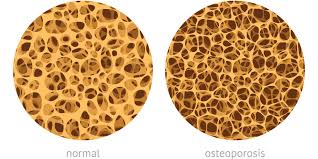Discover the top 5 methods to prevent osteoporosis and safeguard your bone health. Learn essential tips for protecting your body from this condition.
Introduction: Osteoporosis is a condition characterized by weakened bones, making them fragile and more susceptible to fractures. While it’s often associated with aging, there are proactive measures you can take to protect your bone health at any stage of life. In this article, we’ll explore some of the best methods to safeguard your body from osteoporosis.
Understanding Osteoporosis: Before delving into prevention strategies, it’s essential to understand osteoporosis. This condition occurs when the density and quality of bone are reduced, leading to increased bone fragility and risk of fractures. Factors such as age, gender, genetics, and lifestyle habits can contribute to the development of osteoporosis.
To determine if you’re suffering from osteoporosis, several indicators and symptoms can serve as warning signs:
- Fractures: Osteoporosis weakens bones, making them more susceptible to fractures, particularly in the hips, wrists, and spine. A fracture resulting from minor trauma, such as a fall from standing height, could indicate reduced bone density.
- Height Loss: As osteoporosis progresses, compression fractures in the spine can cause a loss in height or a stooped posture (kyphosis).
- Back Pain: Vertebral compression fractures may lead to chronic back pain, which can worsen over time.
- Bone Density Test: A dual-energy X-ray absorptiometry (DXA) scan measures bone density and is the most common method for diagnosing osteoporosis or determining your risk of developing it.
- Risk Factors: Certain risk factors increase the likelihood of developing osteoporosis, including age (especially postmenopausal women), a family history of fractures or osteoporosis, low body weight, smoking, excessive alcohol consumption, and certain medical conditions or medications that affect bone health.
If you’re experiencing any of these signs or have risk factors for osteoporosis, it’s essential to consult a healthcare professional for evaluation and appropriate management. Early detection and intervention can help prevent fractures and mitigate the progression of osteoporosis.
Early Onset Osteoporosis: Risk Factors and Prevention at 30 Years Old
osteoporosis can begin in the thirties for some individuals, especially if there are existing risk factors. Although osteoporosis is often a condition that develops as people age, factors such as genetics, lifestyle, and nutrition can all impact bone health early on.
Certain conditions may increase the likelihood of developing osteoporosis at a younger age, such as inadequate calcium and vitamin D intake, lack of physical activity, alcohol consumption, smoking, family history of osteoporosis or fractures, and certain medical conditions like low estrogen levels in women. Therefore, it is wise to undergo bone density testing, assess risk factors, and initiate early management if there are concerns about osteoporosis developing at a younger age.
Top 5 Methods to Prevent Osteoporosis
Importance of Calcium and Vitamin D: Calcium and vitamin D play crucial roles in maintaining strong and healthy bones. Adequate calcium intake helps build bone mass, while vitamin D facilitates calcium absorption. Incorporating calcium-rich foods such as dairy products, leafy greens, and fortified foods into your diet can promote bone health. Additionally, spending time outdoors and consuming vitamin D-rich foods like fatty fish and fortified cereals can help meet your vitamin D requirements.
Regular Exercise: Engaging in weight-bearing and muscle-strengthening exercises is vital for preventing osteoporosis. Weight-bearing exercises, including walking, jogging,
osteoporosis can begin in the thirties for some individuals, especially if there are existing risk factors. Although osteoporosis is often a condition that develops as people age, factors such as genetics, lifestyle, and nutrition can all impact bone health early on.
Certain conditions may increase the likelihood of developing osteoporosis at a younger age, such as inadequate calcium and vitamin D intake, lack of physical activity, alcohol consumption, smoking, family history of osteoporosis or fractures, and certain medical conditions like low estrogen levels in women. Therefore, it is wise to undergo bone density testing, assess risk factors, and initiate early management if there are concerns about osteoporosis developing at a younger age.
dancing, and stair climbing, help stimulate bone formation and maintain bone density. Strength training exercises using resistance bands, free weights, or body weight can also enhance bone strength and reduce the risk of fractures.
Quit Smoking and Limit Alcohol Intake: Smoking and excessive alcohol consumption can have detrimental effects on bone health. Smoking interferes with calcium absorption and reduces bone mass, increasing the risk of fractures. Similarly, heavy alcohol intake can interfere with the body’s ability to absorb calcium and impair bone formation. Quitting smoking and limiting alcohol consumption can significantly reduce the risk of osteoporosis.
Maintain a Healthy Weight: Maintaining a healthy weight is essential for overall health, including bone health. Being underweight can increase the risk of bone loss and fractures, while obesity can strain the bones and joints. Aim for a balanced diet and regular exercise to achieve and maintain a healthy weight, which can help protect against osteoporosis.
Bone Density Testing and Screening: Regular bone density testing and screening can help detect osteoporosis early and monitor bone health over time. Women aged 65 and older and men aged 70 and older should undergo bone density testing. Younger individuals with risk factors for osteoporosis, such as a family history of the condition or certain medical conditions, may also benefit from screening.
Conclusion: Protecting your body from osteoporosis involves adopting a holistic approach that encompasses lifestyle modifications, dietary changes, and regular exercise. By prioritizing bone health and implementing these strategies, you can reduce the risk of osteoporosis and enjoy a life of mobility and independence.

